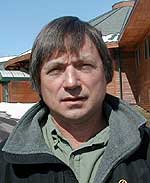By Tim Post
Minnesota Public Radio
April 15, 2002
Highway 169 runs from the Iowa border to the Boundary Waters Canoe Area Wilderness in Minnesota. On summer weekends, it carries thousands of motorists from the Twin Cities to points north. But the highway was never meant to handle the heavy traffic. That's made a two-lane stretch of the road near Lake Mille Lacs a dangerous place to drive. The Minnesota Department of Transportation wants to make the highway safer by expanding it to four lanes. But the project is a challenge because of concerns over the environment, and ancient Native American cultural sites.
| |
|
|
|
||
Neva Williams has lived on Lake Mille Lacs much of her life. Williams swims the lake every day in the summer, and the exercise leaves her younger than her years. She grew up at the Wigwam resort just a few hundred feet from where she lives now. In 1936, her father bought the resort and moved the family from Iowa to Lake Mille Lacs.
She's seen a lot changes along Lake Mille Lacs over the years. It was once mainly a vacation spot for tourists from the Twin Cities and Chicago. Now, she says, it's been developed as a retirement destination.
As Williams sits in her living room, the other major change is obvious. Traffic whizzes by in front of her house on Highway 169. She says the traffic is a challenge especially in the summer.
"In the summer I cross the road to do my daily swim. And when I get out of the water, and try to get back across the highway - especially on a weekend - you wait and you wait and you wait...it's very, very busy," Williams says.
The Minnesota Department of Transportation says 10,000 vehicles travel Highway 169 near Lake Mille Lacs every day. In the summer, the number is close to 18,000. MnDOT wants to make the road safer by expanding it to four lanes. MnDOT engineer Jim Hallgren, who heads up the project, says it's a dangerous road that needs improvement.
| |
|
|
|
||
"Over the last 16 years, we have experienced 24 crashes that resulted in 33 deaths on the highway. There has also been 23 injury accidents each year," says Hallgren.
MnDOT has four potential fixes for the highway. The proposals include building a four-lane highway next to the lake. Another proposal would divert traffic away from the lake to an expressway. Other proposals combine portions of those routes.
Engineer Jim Hallgren says this has been a tricky project to plan, because the area is environmentally sensitive and it holds plenty of sites that are historically and culturally important.
The Tackle Castle is a bait shop south of Lake Mille Lacs on Highway 169. Owner Bill Lundeen says his livelihood depends on the highway. Anglers headed north to catch some of Mille Lacs' walleyes pass right by his front door.
"What they do with the southbound lane - and what they do once they get at least a mile north of us - to me will have very little impact on my business. But just the fact that the northbound lane remains where the present roadway is now, is crucial to the future of our business," Lundeen says.
| |
|
|
|
||
Just a few miles north of Lundeen's business on 169 is the headquarters for the Mille Lacs Band of Ojibwe. The highway splits the tribal community. The band's government center and housing is on one side, with the Grand Casino Mille Lacs on the other. Don Wedll, director of planning for the Mille Lacs Band, says members of the band want to make sure if a new highway is built, their safety is considered.
"We had a series of community meetings and that was clearly the highest priority for the community members, to insure that there was some way to cross 169 that was safe and reasonable. A number of tribal members have been killed on 169 trying to cross it, and so that weighs heavily on how this road is designed," Wedll says.
And although Wedll says safety is the band's main concern, they have others - like how a new four-lane highway would affect the local environment, old villages, cultural sites and artifacts.
The issue is a dilemma for tribal members. They want to protect their history on the lake. But many realize an improved highway would bring more traffic to their casino - and more revenue to the band's bank account. Some of the revenue from the Grand Casino Mille Lacs goes to the band's government, and over the past several years, it has been used to build schools, health clinics, housing and streets.
| |
|
|
|
||
Down the road is Kathios State Park, Minnesota's fourth largest state park. It holds plenty of habitat for eagles, hawks and bears. Manager Aaron Wunrow says a new road would hurt the pristine feel of the 10,000-acre park.
"Having a highway within a couple miles, and in some of our interpretive sites much closer than that - it's a definite noise impact. There's a visual impact, too. The road would actually cut on the edges on the north end of park," Wunrow says.
MnDOT is working with community members and representatives of state and federal agencies on the road proposal. MnDOT will make a final decision on the highway's route by the end of the month. The four-year project will start in 2006 and cost $70 million to $100 million.
Neva Williams and other lakeshore residents hope MnDOT decides to build the new Highway 169 away from the lake. Williams says building an expressway on Mille Lacs would ruin the scenery, which is why people come to the lake.
She has another reason to hope the road travels away from the lake. Her home would be torn down to make way for an expanded Highway 169.
More Information



